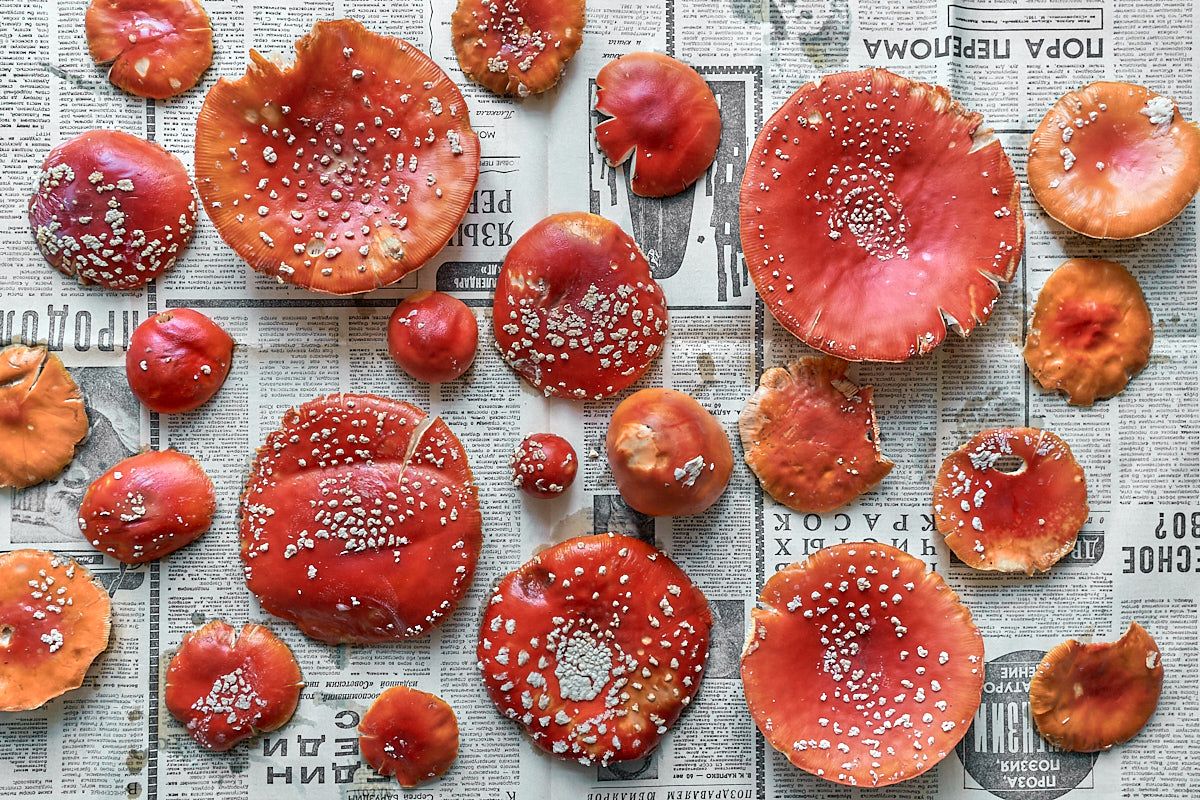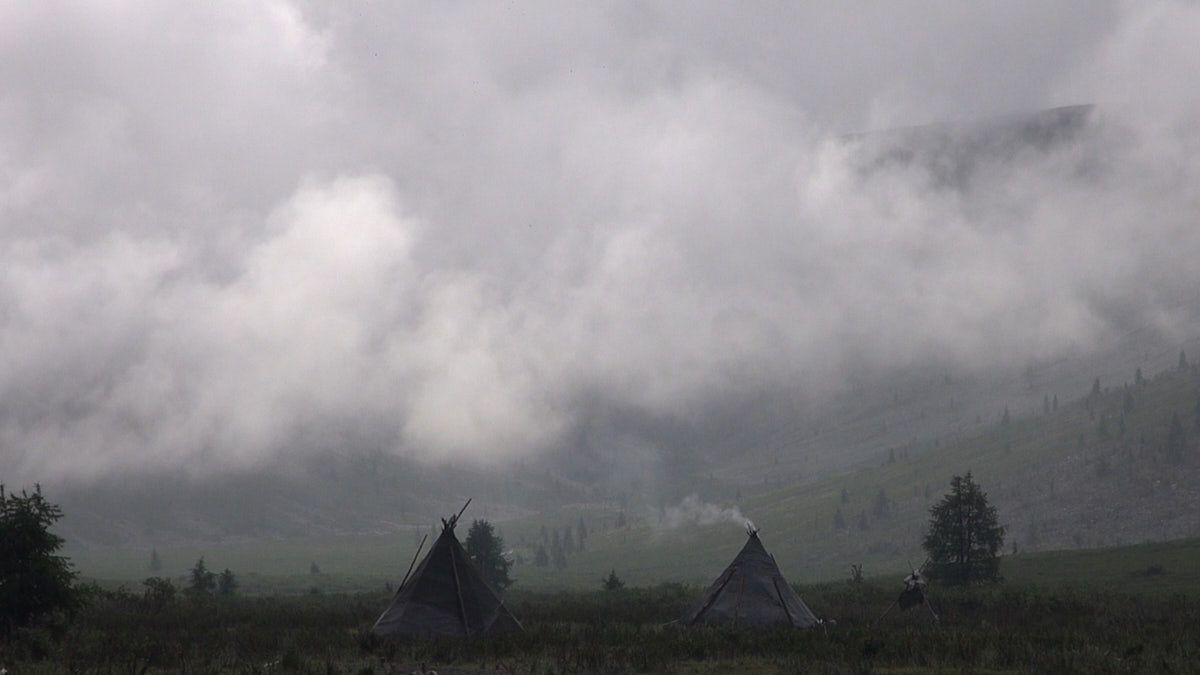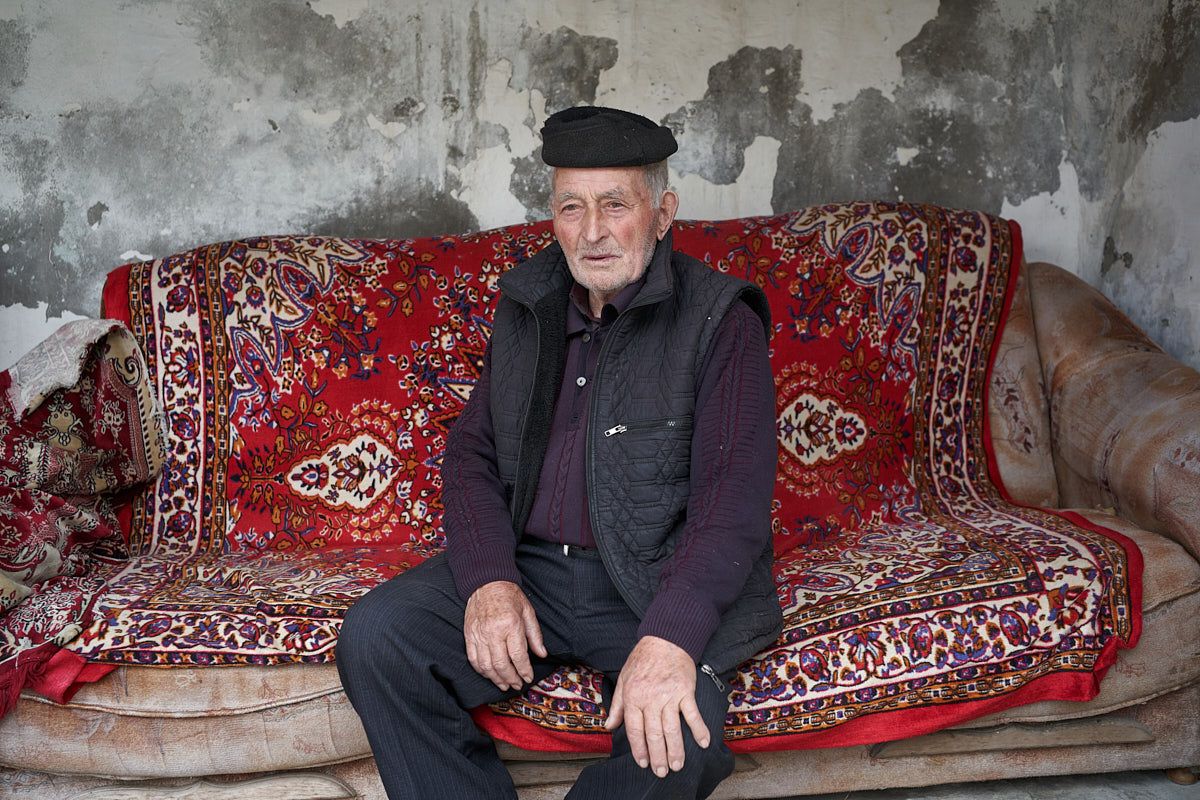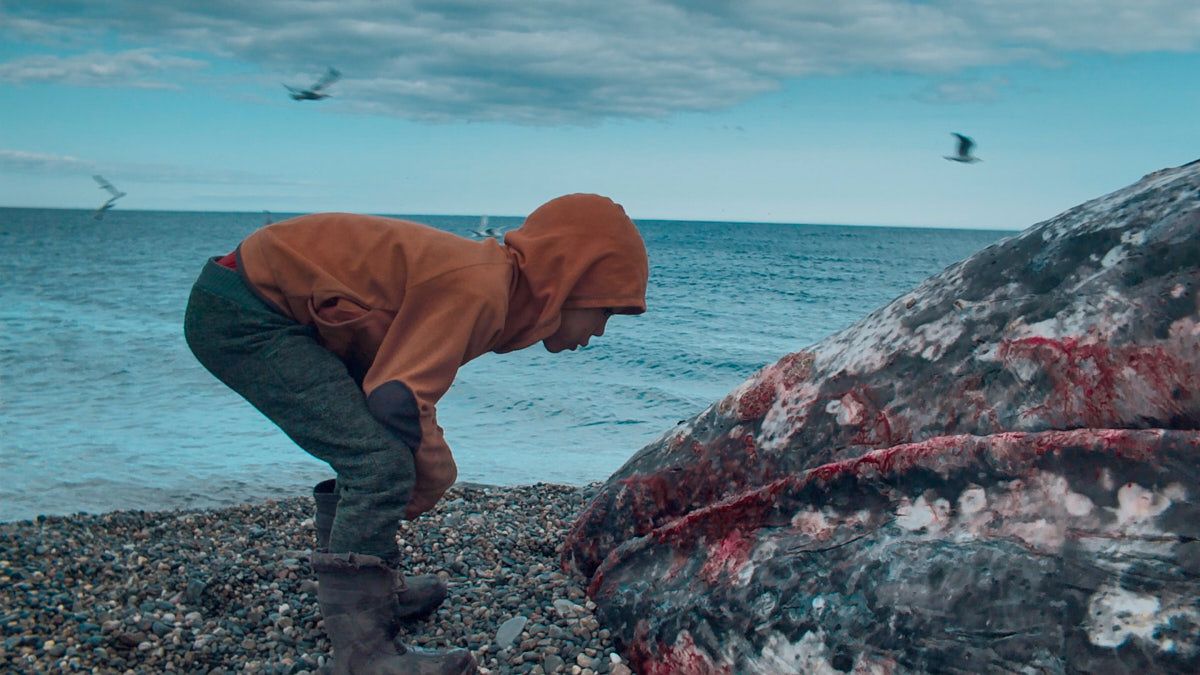blog
Interview with photographers Anastasia Shubina and Timofey Glinin

Preparation of fly agaric for microdosing, St. Petersburg, Russia, 2021. During drying, the amount of toxic substances in the fly agaric decreases and their psychotropic effects increase.
F-Stop Magazine: What led to you each working with photography as artists and how did you decide to start collaborating together?
Anastasia Shubina and Timofey Glinin: We both have diverse backgrounds in art and science and we came to photography quite late. We used to study together at the Faculty of Biology at Saint Petersburg State University. Anastasia then also studied culture and philosophy at the Philosophical faculty. Our collaboration began quite naturally: at first we worked on projects in biology together, then it turned to projects in the field of art.
At this point we see science and art as complementary. For example, we stage perfo-lectures that combine biological reading with experimental video art; we incorporate scientific imaging in art projects. We are also working on a media project dedicated to transhumanism.
Our first art projects were films – we got interested in alternative film processing and visual anthropology and made several experimental and documentary works. We came to photography about two years ago, through an interest in Pictorialism, and shot a photo project with the camera obscura. Then Anastasia entered the School of Modern Photography Docdocdoc, where she studies conceptual documentary and art photography.
Now, we define ourselves as multidisciplinary artists and work with different mediums: photography and cinema, both film and digital, video art and performances.

Ritual of firewalking during Amanita Festival. Kamenskoye, Moscow region, Russia. 2021. The festival is organized and attended by a community of people who regularly consume fly agaric. They gather for several days in the forest, collect, cook and eat fly agaric, and perform rituals that are a reconstruction of ancient pagan holidays.
F-Stop: The current issue of F-Stop Magazine includes your project “Amanita muscaria,” can you tell us about this project? How did you get interested in this topic?
AS & TG: This project was born from our longstanding interest in ancient mythology and shamanism. In 2019, we made a documentary film “The art of falling apart” about Mongolian reindeer herder shamans, and after that we continued to explore shamanic practices.
We found that among the northern peoples, for example, in Siberia and the Russian Far East, shamanism was historically associated with the use of amanita muscaria, or fly agaric. Mushrooms were used to achieve trance and enter the world of spirits. Later the fly agaric became widely used by people from reindeer-herding cultures in everyday life, for example, in traditional medicine or as a tonic.
This story fired our imagination, since in the ordinary mind the fly agaric is perceived as a symbol of a dangerous and lethally poisonous mushroom. However, according to scientific studies, it is not so much toxic as it is hallucinogenic (may cause visions).
We continued our research and found out that amanita muscaria is often found in myths and fairy tales of different peoples of the world, where it is considered a way to access a magical reality. It often grows on the border between the real world and the world of spirits. For example, the home of Baba Yaga (in Slavic folklore – a witch living in the forest) is often described as being surrounded by fly agarics.
However, the most surprising thing was that right now there is a large community of people who actively use fly agaric. Mushrooms are added to cosmetics, massage oils, used in cooking – it is believed that with a certain culinary treatment, fly agaric ceases to be both hallucinogenic and toxic, its microdoses are used as a tonic and an antidepressant, it is a part of neo-pagan rituals and practices.
The photo project “Amanita Muscaria” is an attempt to understand the culture of fly agaric, from ancient, shamanic manifestations to modern times. Visually, amanita is very recognizable in popular culture, though many of its symbolic meanings remain unknown. In this project, we sought to show how ancient traditions and practices are transformed in modern culture, manifested in collective memory and turned into images of mass culture.

Screenshot from the film “The Art of Falling Apart”, devoted to the nomadic reindeer herders living in the north of Mongolia, 2019. For nomads, all of their current diseases and ailments are the result of demons spawned by communism, collectivization, and Soviet repressions. In order to keep them under control, they must turn to shamans and abide by countless taboos.
F-Stop: This project has the feel of being partly documentary and partly fantasy and incorporates found/appropriated images – can you talk a bit about how these different approaches work together in this body of work and how this relates to your creative processes?
AS & TG: The project began as a documentary photographic study of communities of people using amanita muscaria for various purposes, such as microdosing, cooking, medicine, rituals, in art or in scientific research. Then we decided to invite people to visualize their fly agaric experience together with us. For this, we used costumes and masks, as well as art objects created by them.
However, we soon realized that this was not enough to reveal the culture of fly agaric, since it is rooted in history and contains a number of practices that have ceased to be used, but the memories of them remained in the culture.
We started working with archives and collecting old fly agarics postcards, vintage photographs, and children’s toys. We began to move away from documentary fixation, and reflect the sensations from the use of fly agaric in the visual language. Some of the photographs in the project are inverted, as historically, fly agaric hallucinations were perceived as a “spirit world”, in which things turn into their opposites.
Other methods used in the project are installations and reconstructions. Based on documentary sources, we recreated fly agaric recipes, methods of harvesting and drying, and the use of amanita to kill insects.
Though we tried to base our project on documentary sources, historical information about fly agaric practices is fragmentary and subjective, and often contains stories of people who were not personally present at these rites, but who learned about them as old legends. So, we were rather reconstructing the imagination of people who lived long before us.
Thus, we came up with the idea to complement the project with “imaginary archives”, images created by artificial intelligence, based on historical descriptions and quotes from interviews.

Azret Korakotov, a Karachay survivor of the 1943-1956 mass Deportation, at his home in Kart-Dzhurt aul, Karachay-Cherkessia, Russia, 2021. Together with his family, he was deported to Kazakhstan, where he grazed sheep as a child. In 1957, after the rehabilitation of the Karachays, he and his family were able to return home to the Caucasus.
F-Stop: How do you generally choose the projects you work on together?
AS & TG: We are interested in topics related to anthropology, mythology and the collective unconscious. We have also worked (together and separately) on projects focusing on historical trauma and its impact on people’s daily lives. One of the projects was devoted to the consequences of the deportation of the Karachay people in the USSR in 1943. Another project – the film “The Art of falling apart” is dedicated to the consequences of communist repressions for a tribe of nomadic reindeer herders in the north of Mongolia.
The project “Amanita muscaria” also has a historical dimension and allows you to look at modern reality in Russia through the prism of ancient pagan practices that have survived and are undergoing transformation.
F-Stop: Are you working on any other projects currently?
AS & TG: We are finishing work on the documentary film “Piblokto”, or Arctic Hysteria, about the Chukchi and Eskimos living on the coast of the Arctic Ocean. “Piblokto” is a visual meditation that reveals the life of the people of the Far North, hunting for walruses and whales and protecting villages from bears.
In addition, we are working on a photo book “Amanita Muscaria”, and we are preparing to launch an art project dedicated to transhumanism and immortality.

Screenshot from the film “Piblokto”, about the life of the Chukchi and Eskimos living on the coast of the Arctic Ocean, Russia. Life of people is centered around hunting for walruses and whales and protecting villages from bears coming from the tundra. This turns the film into a reflection about death.
F-Stop: What or who are your photography inspirations – and why?
AS & TG: Though we use photography in many projects, our main sources of inspiration are in the cinema. When working on photo projects, we are primarily inspired by film essays: for example, “The Pervert’s Guide to Cinema” with the philosopher Slavoj Žižek, where a psychoanalytic approach to understanding cult movies is used, Chris Marker’s film essays, combining archives and the author’s footage; the experimental films of Ben Rivers, often using a mockumentary approach. We are interested in the unexpected relationships that arise between text and images, as well as between different “layers” of images, playing with interpretations, understatement and leaving space for the imagination.
::
GLISH is an art association founded by Timofey Glinin and Anastasia Shubina, visual artists, working together from 2018. Currently based in San Francisco.
Anastasia Shubina is a multidisciplinary artist from St. Petersburg. She works with documentary and conceptual photography, film and video art. He has a philosophical education, as well as education in the field of cinema and photography. Her work has been presented at solo and group exhibitions, as well as at a number of film festivals in Europe, Asia, America and Australia. Finalist and winner of competitions. In her personal projects, she explores the themes of mythology, anthropology, and historical trauma.
Timofey Glinin is an artist and film director from St. Petersburg. He studied biology at Saint Petersburg State University and attended courses at the Saint Petersburg School of New Cinema, worked as a scientist, entrepreneur, and writer. His work has been presented at a number of international film festivals and exhibitions in Europe, Asia, the USA and Australia. In his projects, he explores the themes of futurism, transhumanism and modern science.
To see more of Anastasia and Timofey’s work visit the Portfolio 2022 issue of F-Stop or their website glish.org
Location: Online Type: Featured Photographer, Interview
Events by Location
Post Categories
Tags
- Abstract
- Alternative process
- Architecture
- Artist Talk
- artistic residency
- Biennial
- Black and White
- Book Fair
- Car culture
- Charity
- Childhood
- Children
- Cities
- Collaboration
- Community
- Cyanotype
- Documentary
- Environment
- Event
- Exhibition
- Faith
- Family
- Fashion
- Festival
- Film Review
- Food
- Friendship
- FStop20th
- Gender
- Gun Culture
- Habitat
- Hom
- home
- journal
- Landscapes
- Lecture
- Love
- Masculinity
- Mental Health
- Migration
- Museums
- Music
- Nature
- Night
- nuclear
- p
- photographic residency
- Photomontage
- Plants
- Podcast
- Portraits
- Prairies
- Religion
- River
- Still Life
- Street Photography
- Tourism
- UFO
- Water
- Zine

Leave a Reply